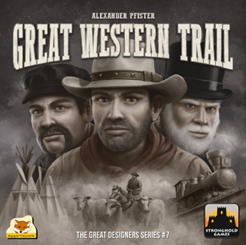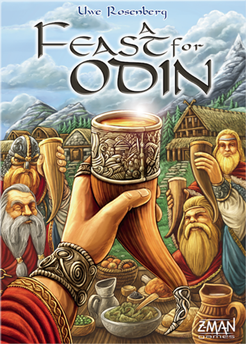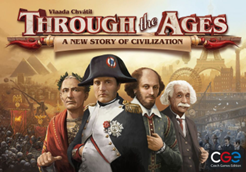A Magic: the Gathering pre-release event meant that we couldn’t play D&D Adventurers League games on Saturday. So, instead, I played a few board-games with one of my friends.
Great Western Trail
 This is one of my favourite games at present. We played two games on Saturday, each lasting a little under an hour. It plays very well with two to four players. With four players, it lasts about 2 hours.
This is one of my favourite games at present. We played two games on Saturday, each lasting a little under an hour. It plays very well with two to four players. With four players, it lasts about 2 hours.
The rulebook is horrid, but the gameplay is fantastic. Mechanically, it has a few complexities, but most of the game rules are easy to learn – especially once you’ve played a round or two. It manages to combine a few mechanics. You erect buildings on the trails leading to the cities, you send a train carrying cattle to more and more cities, and you gather a herd of superior cattle as you make your way along the trail. Each of these things interconnects: The train visits more cities if your cattle herd is better and gives you more money with which to build buildings and purchase cattle. The buildings help you move the train further and get more cattle.
On your turn, you move your worker up to 3 spaces along the trail, trying to avoid hazards and buildings built by opponents that tax you, and land on buildings that you own or are neutral. The trail splits every so often, which makes the choice of which branch to erect buildings on and to follow quite interesting.
As you complete various tasks, you unlock features on your player board: Perhaps you can move further, have a bigger herd of cattle, or improve the quality of those cattle by culling the herd.
The game offers several paths to victory, and the random set-up of the neutral buildings and the buildings available for players to construct makes it fantastically replayable. You always have a different set-up to explore. The game rewards the exploration of its mechanics; even if I lose trying something new, I still learn something. Highly recommended.
A Feast for Odin
 Uwe Rosenberg is a very talented designer. However, I’m becoming quite disillusioned with his higher-complexity games. I very much enjoy Ora et Labora, and I’ve played a lot of Agricola, but games like Le Havre and A Feast for Odin wander into a level of complexity that I don’t enjoy.
Uwe Rosenberg is a very talented designer. However, I’m becoming quite disillusioned with his higher-complexity games. I very much enjoy Ora et Labora, and I’ve played a lot of Agricola, but games like Le Havre and A Feast for Odin wander into a level of complexity that I don’t enjoy.
I’m not sure if A Feast for Odin is the most complex of his games, but it certainly feels like it may be the least obvious. If you’re not playing this game on a weekly basis, you’re probably going to lose track of the strategies to follow. While in Great Western Trail, the results of your actions are apparent, and you get to see their result, if you perform bad moves in A Feast for Odin, you come out the other side not knowing why you lost.
That makes it not the best game for casual gamers.
The game casts you as the leader of a group of Vikings, and you need to find food for them through hunting or purchasing, send them to plunder treasure or craft goods to trade. The action board is massive, containing 74 action spaces! The actions typically allow you to transform one type of thing into another type of thing, or to gather basic things that you’ll later transform. Occasionally, you roll dice to find out how successful your actions were, with some rerolls allowed so everyone can marvel at how unlucky you are.
The game isn’t as engine-based as many others, although you do need to get ships (in one of three types) to perform whaling, exploration or pillaging. The cards aren’t as significant as the cards in Agricola, but they can affect your strategy and allow you to consider actions you’d otherwise ignore.
However, the actions are very difficult to judge their effects when you’re new to the game. The game also doesn’t give me a great feeling of accomplishment. In Agricola, I can at least see that I’ve completed a farm. With A Feast for Odin, I’ve covered a board with green and blue tiles! Recommended only for those who enjoy highly complex strategy games and who’ll play it often.
Through the Ages
 I’ve played more games of Through the Ages than any other board-game except for Carcassonne and Settlers of Catan. As Through the Ages takes at least an hour per player, this is some accomplishment! (The number? It’s over 100 games!) It’s the one Civilisation-type game I’ve played I thoroughly enjoy.
I’ve played more games of Through the Ages than any other board-game except for Carcassonne and Settlers of Catan. As Through the Ages takes at least an hour per player, this is some accomplishment! (The number? It’s over 100 games!) It’s the one Civilisation-type game I’ve played I thoroughly enjoy.
This is another game where what you can do is obvious, although the long-term effects are a bit hazier. In short, you have farms and mines making your basic supplies. You need food to recruit and maintain your population, who you then assign to various buildings you’ve discovered: more farms and mines, the army, or urban buildings such as temples, laboratories and libraries. The object of the game is to end with the highest culture, which is produced primarily through your urban buildings and wonders, but you’ve got to pay attention to your infrastructure as well (happiness, knowledge, food and production).
You also have a military you need to upkeep, lest your neighbours take advantage!
You never have enough resources to do everything, and so it’s a balancing act throughout the game.
New technology, wonder and action cards become available through a track that has old cards being discarded and new cards being added every turn. The cost to pick-up a card in actions varies according to how long it’s been on the track, and there are times when spending three actions (which could be 75% of your actions for a turn!) to get that Iron may be what you need to do.
As the order of cards is random, although split into one of four ages, you need to adapt your strategy each game to the new presentation.
This is a tremendous game, and the new edition is a distinct improvement on the original. Highly recommended!
So that was my Saturday – playing these three highly-rated games, even though one isn’t really to my tastes. I won one game of Trail and lost the other. I lost Feast, but I managed a come-from-behind win of Through the Ages (I was losing by 80+ points about halfway through!)
